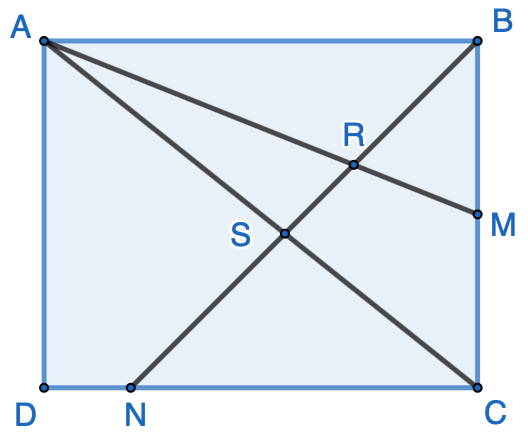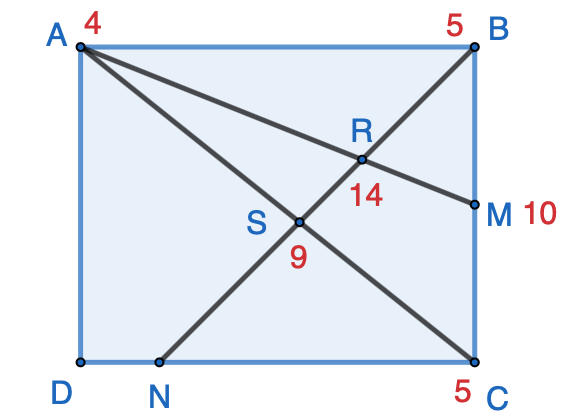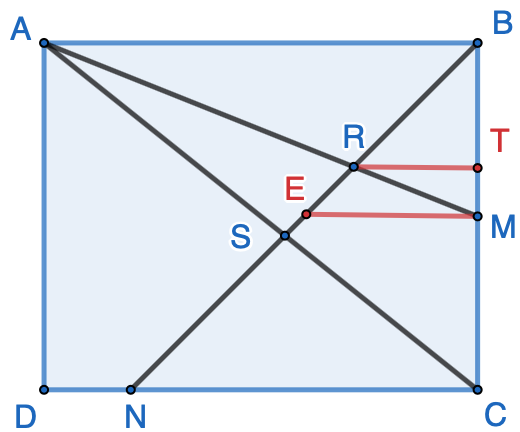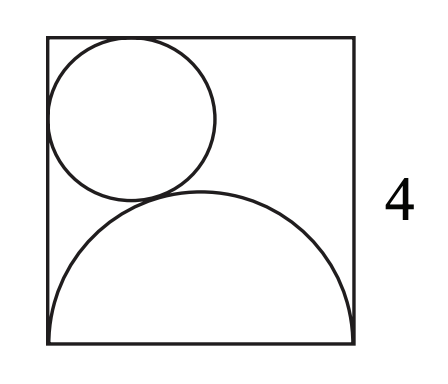In rectangle $ABCD$, shown here, point $M$ is the midpoint of side $BC$, and point $N$ lies on $CD$ such that $DN:NC=1:4$. Segment $BN$ intersects $AM$ and $AC$ at points $R$ and $S$, respectively. If $NS:SR:RB=x:y:z$, where $x$, $y$ and $z$ are positive integers, what is the minimum possible value of $x + y + z$? Source: MATHCOUNTS 2012 State Sprint Round. Click here for solutions.
Solution 1 – Using Similar Triangles Please visit
Art of Problem Solving for using
Similar Triangles and Proportional Reasoning to solve the problem.
Solution 2 – Using Mass Points This may be the simplest method found without drawing extra lines.
$$ \because DN:NC=1:4 $$
$$ \therefore CN:AB=CN:CD=NC:(DN+NC)=4:(1+4)=4:5$$
$$ \because AB \parallel CD \ \ \ and \ \ \angle{ASB}=\angle{CSN} $$
$$ \therefore \triangle{ASB} \sim \triangle{CSN}$$
$$ \therefore NS:BS=CS:AS=CN:AB=4:5\tag{1}$$
For $\triangle{ABC}$, let $A_{mass}=4$, $C_{mass}=5$, then, $$S_{mass}=A_{mass}+C_{mass}=4+5=9$$ Because $M$ is the midpoint of $BC$, $B_{mass}=C_{mass}=5$, and $$M_{mass}=B_{mass}+C_{mass}=5+5=10$$ Finally, we have balanced mass at $S$: $$S_{mass}=A_{mass}+M_{mass}=B_{mass}+S_{mass}=14$$  Therefore $$RB:BS=9:14\tag{2}$$ $$SR:BS=5:14\tag{3}$$ Combine (1), (2) and (3), we have: $$NS:SR:RB=(NS:BS):(SR:BS):(RB:BS)=(4:5):(5:14):(9:14)$$ $$= (56:70):(25:70):(45:70)=56:25:45=x:y:z$$ Therefore, $x+y+z=56+25+45=126$
Therefore $$RB:BS=9:14\tag{2}$$ $$SR:BS=5:14\tag{3}$$ Combine (1), (2) and (3), we have: $$NS:SR:RB=(NS:BS):(SR:BS):(RB:BS)=(4:5):(5:14):(9:14)$$ $$= (56:70):(25:70):(45:70)=56:25:45=x:y:z$$ Therefore, $x+y+z=56+25+45=126$
Solution 3 – Using Crossed Ladders Theorem Draw line $RT$ parallel to $AB$ and intersecting $BC$ at $T$, and line $ME$ parallel to $AB$ and intersecting $BN$ at $E$.
 $$ \because DN:NC=1:4 $$ $$ \therefore AB:CN=CD:CN=(DN+NC):NC=(1+4):4=5:4 \tag{1}$$ $$ \because AB \parallel CD \ \ \ and \ \ \angle{ASB}=\angle{CSN} $$ $$ \therefore \triangle{ASB} \sim \triangle{CSN}$$ $$ \therefore BS:NS=AB:CN=5:4$$ $$BS:BN=BS:(BS+NS)=5:(4:5)=5:9 \tag{2}$$ Applying Crossed ladders theorem, we have $$ \because RT \parallel AB \parallel EM \parallel CD $$ $$ \therefore \frac{1}{RT}=\frac{1}{AB}+\frac{1}{EM}\tag{3}$$ Additionally $$ \because ME \parallel CN $$ $$ \therefore \triangle{BME}\sim\triangle{BCD} $$ Because point $M$ is the midpoint of side $BC$, therefore $$EM:NC=BM:BC=1:2$$ Apply (1), we have $$EM=\frac{1}{2}NC=\frac{1}{2}\cdot\frac{4}{5}AB=\frac{2}{5}AB\tag{4} $$ Apply (4) to (3), we have $$ \frac{1}{RT}=\frac{1}{AB}+\frac{1}{\frac{2}{5}AB}=\frac{7}{2}\cdot\frac{1}{AB}$$ $$\therefore RT:AB=2:7$$ Apply (1), we have $$RT:NC=(RT:AB) \cdot (AB:CN) = (2:7)\cdot(5:4)=5:14$$ $$ \because \triangle{BTR} \sim \triangle{BCN} $$ $$\therefore RB:NB=RT:NC=5:14\tag{5}$$ $$\therefore SR:NB=(BS-RB):NB = BS:NB-RB:NB=\frac{5}{9}-\frac{5}{14}=\frac{25}{126}\tag{6}$$ Additionally, $$NS:NB=NS:(NS+SR)=4:(4+5)=4:9\tag{7}$$ Combine (5), (6) and (7), we have: $$NS:SR:RB=(4:9):(25:126):(5:14)=56:25:45=x:y:z$$ Therefore, we reach the same answer: $x+y+z=56+25+45=126$
$$ \because DN:NC=1:4 $$ $$ \therefore AB:CN=CD:CN=(DN+NC):NC=(1+4):4=5:4 \tag{1}$$ $$ \because AB \parallel CD \ \ \ and \ \ \angle{ASB}=\angle{CSN} $$ $$ \therefore \triangle{ASB} \sim \triangle{CSN}$$ $$ \therefore BS:NS=AB:CN=5:4$$ $$BS:BN=BS:(BS+NS)=5:(4:5)=5:9 \tag{2}$$ Applying Crossed ladders theorem, we have $$ \because RT \parallel AB \parallel EM \parallel CD $$ $$ \therefore \frac{1}{RT}=\frac{1}{AB}+\frac{1}{EM}\tag{3}$$ Additionally $$ \because ME \parallel CN $$ $$ \therefore \triangle{BME}\sim\triangle{BCD} $$ Because point $M$ is the midpoint of side $BC$, therefore $$EM:NC=BM:BC=1:2$$ Apply (1), we have $$EM=\frac{1}{2}NC=\frac{1}{2}\cdot\frac{4}{5}AB=\frac{2}{5}AB\tag{4} $$ Apply (4) to (3), we have $$ \frac{1}{RT}=\frac{1}{AB}+\frac{1}{\frac{2}{5}AB}=\frac{7}{2}\cdot\frac{1}{AB}$$ $$\therefore RT:AB=2:7$$ Apply (1), we have $$RT:NC=(RT:AB) \cdot (AB:CN) = (2:7)\cdot(5:4)=5:14$$ $$ \because \triangle{BTR} \sim \triangle{BCN} $$ $$\therefore RB:NB=RT:NC=5:14\tag{5}$$ $$\therefore SR:NB=(BS-RB):NB = BS:NB-RB:NB=\frac{5}{9}-\frac{5}{14}=\frac{25}{126}\tag{6}$$ Additionally, $$NS:NB=NS:(NS+SR)=4:(4+5)=4:9\tag{7}$$ Combine (5), (6) and (7), we have: $$NS:SR:RB=(4:9):(25:126):(5:14)=56:25:45=x:y:z$$ Therefore, we reach the same answer: $x+y+z=56+25+45=126$









